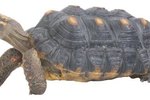
Russian tortoises are 3 to 4 inches long when they first hatch and grow to between 8 and 10 inches long. They are found commonly in southeastern Russia, as well as Afghanistan, northwestern Pakistan, eastern Iran, northwestern China and Kazakhstan. Their gentle disposition makes these herbivores ideal pets. In the wild they live an average of 20 years, while in captivity they can live for 50 or more years.
Natural Habitat
Russian tortoises thrive in dry, open areas. They keep to sandy locations, where they can get around easily as well as burrow. Despite preferring arid environs, Russian tortoises can survive in ease where humidity is 70 percent, and actually need some rain to soften the soil so they can dig their burrows. When the soil is too dry, Russian tortoises are unable to dig at all.
Life in the Burrow
Russian tortoises retreat to their burrows to escape the unmerciful midday heat. They also head to their burrows at night. They actually are quite social, and will visit nearby burrows. Russian tortoises even have their own version of sleepovers on occasion, as a few of them will spend the night together in one burrow.
Hibernation
These tortoises hibernate during winter and during the hottest days of summer. Their winter hibernation runs from October to March. They are active on land, particularly for mating purposes, from March until the middle of June.
Food and Water
The Russian tortoise subsists on a diet of broad-leaf plants and weeds. They especially favor dandelions. Since they do prefer arid, sandy areas, it is not surprising that they can survive with very little water. However, they cannot be entirely deprived of water, so these tortoises have evolved to reserve water from the food they eat.
In Captivity
Russian tortoises in captivity require space to move around. They are expert diggers so provide them with substrate so they can burrow but ensure that they won’t be able to dig out and escape. Indoor enclosures should be at least 36 by 12 inches and outdoor enclosures should be at least 48 by 48 inches. Russian tortoises that are kept outside should have a secure screen over their enclosure to prevent them from climbing out. Substrate also should be digestible, since Russian tortoises have a tendency to consume it. Rabbit and alfalfa pellets are ideal, because they will allow the tortoise to burrow and won’t make it sick if consumed nor scratch its carapace. A shallow container with water should be included so the tortoise can drink from it and also soak in it, and the water should be changed daily. The enclosure should be cleaned daily to remove leftover food and feces and cleaned thoroughly once a week. Russian tortoises in captivity thrive in temperatures no lower than 75 degrees Fahrenheit, and no higher than 85 degrees Fahrenheit.
References
Photo Credits
-
Jupiterimages/Photos.com/Getty Images
Writer Bio
Vivian Gomez contributes to Retailing Today, the Daily Puppy, Paw Nation and other websites. She's covered the New York Comic Con for NonProductive since 2009 and writes about everything from responsible pet ownership to comic books to the manner in which smart phones are changing the way people shop. Gomez received her Bachelor of Arts in English literature from Pace University.


